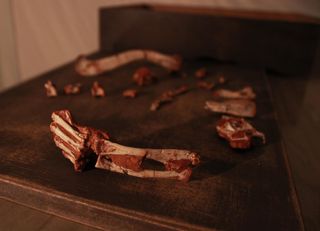'Edward Scissorhands' creature that lived 230 million years ago discovered in Brazil
The ancient predator, which scientists have named Venetorapter gassenae, also had a large beak and likely used its claws for climbing trees and picking prey apart.

An ancient reptile with massive hands and long, sword-like claws has been unearthed in southern Brazil. Its "hands and claws, which look a bit like those of Edward Scissorhands, may have been used to catch prey or climb trees," Rodrigo Müller, a paleontologist at the Federal University of Santa Maria in Brazil, told Live Science.
Müller and his team discovered the reptile’s remains in a rice farm in the state of Rio Grande do Sul in southern Brazil.
The strange creature lived about 230 million years ago during the Triassic period (252 million to 201 million years ago). It had a large, sharp beak that it likely used to tuck into insects, fruits and small animals such as lizards, Müller said. Its claws would likely have been used for climbing and processing prey.
In honor of its distinctive raptor-like beak and grasping claws, the researchers named the reptile Venetorapter gassenae.
By analyzing skeletal fragments, the scientists estimate that V. gassenae would have stood roughly 27.5 inches (70 centimeters) tall and around 39 inches (1 meter) long. Features of the bone suggest the animal was an adult, Müller said.

With feather-like fur and a long tail, V. gassenae is a type of lagerpetid — a group of reptiles that were precursors to pterosaurs, flying reptiles that dominated the sky during the time of the dinosaurs.
Sign up for the Live Science daily newsletter now
Get the world’s most fascinating discoveries delivered straight to your inbox.
An elongated fourth digit on V. gassenae's fossilized right hand has not been previously seen in lagerpetids, hinting that V. gassenae's is especially closely related to pterosaurs, said Müller.
"This elongated fourth digit supports the wings in pterosaurs, so V. gassenae may represent the transition of lagerpetids towards pterosaurs," he said.
It is generally thought that lagerpetids were less anatomically diverse than pterosaurs and dinosaurs, Müller noted. But by analyzing the shape and size of fossils from 18 dinosaur and 10 pterosaur species, along with their reptilian precursors — including V. gassenae — the team found that lagerpetids may have been as diverse as pterosaurs and more diverse than the dinosaurs that roamed during the Triassic period.
The discovery of more V. gassenae fossils may help to paint a clearer picture of what the fascinating creature ate, what it looked like and where it lived, said Müller.

Carissa Wong is a freelance reporter who holds a PhD in cancer immunology from Cardiff University, in collaboration with the University of Bristol. She was formerly a staff writer at New Scientist magazine covering health, environment, technology, nature and ancient life, and has also written for MailOnline.
Most Popular


